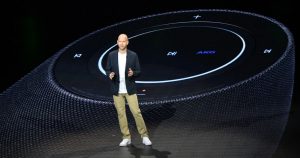Monster trucks. You might think, hey, it’s just a truck with giant tires. Oh, but no. These trucks are also incredibly powerful. They can jump and bounce and do wheelies. They can even do flips in the air. First it was a backflip, but at the Monster Jam World Finals XVIII, a truck known as Mad Scientist pulled off an eye-popping, first-ever front flip. For real. Here’s the video.
This is a great opportunity to go over the physics of both front flips and backflips. You know, just in case you find yourself behind the wheel of a monster truck anytime soon.
Let’s Talk Torque
I’m going to start with the backflip, since this one is obviously easier. How do you make a truck flip completely over? You need to exert a torque.
What the heck is that? Torque is like a force, except different. Forces are interactions that change the linear motion of an object, but torques change the rotational motion of an object. I like to call torque a “rotational force.”
Here’s a quick experiment for you. Take a pencil and place it on a table. Now push it with your finger in the center of the pencil. Like this:
Yes, that’s a very basic pencil, but it’ll work. If you push it in the middle, the pencil will accelerate to the left (assuming the frictional force is negligible). That’s what forces do. Now suppose you push the pencil near the end:
Since the force isn’t acting at the center of mass, it will create a torque. The pencil will both accelerate and increase in rotational velocity. That’s torque. The magnitude of the torque depends on two things: (1) how much force you apply and (2) the distance (r) from the center of mass, called the torque arm. Pushing farther from the center produces more torque. (OK, the torque also depends on the angle between the force and the object—but let’s keep it simple for now.)
What’s this got to do with monster trucks? You need a torque if you want to do a backflip. The torque will cause a change in rotational motion, and the truck will go from its horizontal orientation into a spin. You also need an upward-pushing force to get the truck off the ground; otherwise it’s just a truck rolling on the ground, and no one’s paying to see that.
The most common method of launching a backflip is to use a very steep ramp. When the truck goes up this ramp, there will be a force (Ff) pushing on the front tires to produce a counterclockwise torque around the truck’s center of mass. Maybe this diagram will help:
In this situation, the force from the back tires (Fb) also contributes to the torque. This is a frictional force between the tires and the ground, and it pushes forward as the truck accelerates into the jump. (There would also be a frictional force on the front tires, but I left it off since they will soon lose contact with the ramp.) The diagram also shows the downward arrow of the gravitational force. However, since it’s at the center of mass, it doesn’t contribute any torque.
After the truck launches, there are no external torques to change its rotational motion. But since it started the counterclockwise rotation, it continues to rotate in the air. The only question is whether it will make it back to a wheels-down position before landing. If not—oh well, these trucks are built for punishment. That’s why they’re monsters.
How to Pull a Wheelie
Before we get to the front flip, there’s another stunt you need to master first—the wheelie, where you drive with the front wheels off the ground. How does it work? Let’s start with another force diagram:
In this position, the truck is stable—there is no rotational motion. As before, the gravitational force acts at the center of mass. The force from the ground is not applied at the center of mass, but notice that if you extend a line from that arrow, it would pass right through the center of mass. That means this force also has a zero torque arm, so it creates no torque.
But wait. Why does the ground force point that way? It’s actually a combination of two forces: First, there is the upward-pushing force from the ground. This is an interaction between the tire and the ground that prevents the truck from falling through the dirt. (It’s the same force that pushes up on your coffee cup to keep it from passing through the table.) This is called the “normal” force, because it’s perpendicular to the surface.
Second, there is the frictional force from the back tires. This force pushes forward, parallel to the ground. Combine those two and the net force points diagonally up to the right. This is the whole key to pulling a wheelie: You need to hit the perfect frictional force to aim that arrow right at the center of gravity. That’s all driver skill.
You can see that the net force causes the truck to accelerate forward. Oh, there is a way to do a wheelie without accelerating. If you had the center of mass directly over the back wheel, then the force from the ground would push straight up and again produce zero torque. However, in this case I think the monster truck is accelerating.
The Secret to the Front Flip
Now for the finale! So for a truck moving to the right, you need to create a clockwise torque to make it somersault forward. That’s pretty tough. The key is to have only the back wheels hit the ramp. And that’s exactly what the Mad Scientist driver does, as you can see in the video (at 2:00)—as he approaches the ramp, he guns it into a wheelie. Here is a force diagram:
Since the front wheels are off the ground, they miss the small ramp—there is no force exerted on the front wheels. Then, when the back wheels hit, the ramp pushes both back and up. The direction of this ramp force produces the necessary clockwise torque. This increases the rotational motion of the truck in the clockwise direction. Once again, after it leaves the ramp, it continues to rotate in the same direction as long as it stays aloft. In this case, Mad Scientist completes a full rotation before landing. Honestly, it’s quite impressive.
OK, one last thing. If there is indeed a backward-pushing force on the rear wheels, then the truck’s horizontal velocity should decrease—that’s what forces do after all: They change the motion of an object. My plan was to use video analysis to show this decrease in velocity, but it didn’t quite work. The motion of the camera and the viewing angle makes an accurate analysis impossible. However, since I did it anyway—here is my plot of the trajectory of the two sets of wheels along with the center of mass (approximate).
Well, you can sort of see the decrease in horizontal velocity—but it’s not super clear. It’s still a cool plot. It’s definitely a cool jump.
More Great WIRED Stories
- Behind the scenes at Rotten Tomatoes
- The tiny brain cells that connect our mental and physical health
- Inside the world’s highest-stakes industrial hacking contest
- Laser headlights can make roads brighter—and cars smarter
- 404: The city left behind by China’s nuclear ambitions
- 👁 The secret history of facial recognition. Plus, the latest news on AI
- ✨ Optimize your home life with our Gear team’s best picks, from robot vacuums to affordable mattresses to smart speakers



